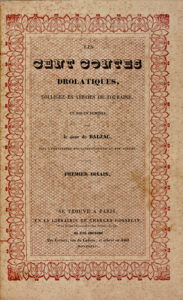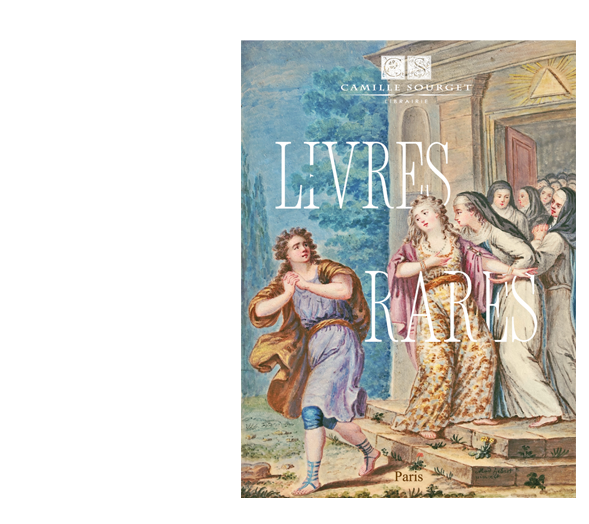Paris, Gosselin puis Werdet, 1832-1833-1837.
3 volumes 8vo of: I/ 396 pp., (2) ll. of errata and table; II/ 416 pp.; III/ 369 pp., (1) blank page, (3) sheets of notes, table, and errata. Full chocolate morocco, framing with six gilt fillets around the covers, spines with raised bands decorated with compartments with five gilt fillets, inner frame with 6 gilt fillets, gilt over marbled edges, printed wrappers bound in except for the 2nd wrapper of volume III. Binding signed Chambolle-Duru.
207 x 130 mm.
Very rare assembly of the three dizains in original editions, the December 1835 fire having destroyed a large part of the stock.
Clouzot, p.20; Carteret, I, p.63; Vicaire, I, 189.
“One of the rarest romantics, both for the importance of its text and for the difficulty of gathering these three Dizains, which appeared from 1832 to 1837, with a five-year gap between the second and the third.
This work in contemporary binding, or unbound with the covers, will always be the rare bird!” (Carteret).
“The three volumes of Contes drolatiques, in original edition, are very rare and highly sought after. That of the third dizain is even particularly rare, the fire at rue du Pot de fer having destroyed part of the edition.” (Vicaire).“The cover of volume III on yellow paper is dated 1838. Volume III, the most difficult to find, was put back on sale in 1839 under the title ‘Berthe la Repentie’. It is extremely difficult to find these three volumes in uniform period bindings or in modern bindings with their covers.“ (Clouzot)
The fourth Dizain announced never appeared.
On December 12, 1835, part of the Contes Drôlatiques was destroyed by the disastrous fire in rue du Pot-de-Fer. “The fire at rue du Pot-de-Fer, Balzac wrote to Mme Hanska, consumed the first 160 pages printed at my expense of the third dizain of the Contes drolatiques et 500 volumes, which cost me four francs each, of the first and second dizains. Not only do I lose three thousand five hundred francs in cash and the interest, but I also lose a market of six thousand francs that I cashed in to pay my year’s end and which is now ruptured, as I cannot deliver anything to Werdet and a partner for this business, who were buying the three dizains from me. (Lettres à l’étrangère, I, 287).
The true tutelary god of this collection is Rabelais, emulated in the pure mischief of a style apparently naive, very colorful and flavorful, in the triumphant sensuality without prejudice and even in the long lists of synonymous terms to which he so delighted. Indeed, Balzac boasts of being “tourangeau” like his great predecessor, and his book carries the complete title: Les Cent Contes drolatiques collected in the abbeys of Tourayne, and brought to light by the sieur de Balzac, for the amusement of the Pantagruelists and none others. Rabelais himself appears in one of these tales (“Le Prosne du joyeulx curé de Meudon”).
Balzac joyously draws from each Tale, “according to the maxims of great ancient authors”,a precept or a “lesson” where he often jests about religion or traditional morality, in a tone of agreeable skepticism that will later be that of Anatole France. Despite the insistent archaism of the language, this work fits into the taste of the 18th century: in this current of literary narrative art, mischievous and amiably disrespectful, full of flavorful appeals to the “Gaulish”tradition, inaugurated by the great master of the Parnassians Théophile Gautier and which found its splendid conclusion in La Rôtisserie de la reine Pédauque, by the ex-Parnassian Anatole France.
The usual power of Balzac marks certain tales with the sign of his genius.
Precious copy, particularly wide-margined (height: 207 mm), finely bound by Chambolle-Duru with the printed wrappers bound in.

![Les cent Contes drolatiques, colligez ès abbaïes de Touraine et mis en lumière par le sieur de Balzac, pour l’esbattement des pantagruelistes et non aultres. Premier [Second-Troisième] Dixain.](https://www.camillesourget.com/wp-content/uploads/2025/04/041-B_BT141576_078_2.jpg)
![Les cent Contes drolatiques, colligez ès abbaïes de Touraine et mis en lumière par le sieur de Balzac, pour l’esbattement des pantagruelistes et non aultres. Premier [Second-Troisième] Dixain. - Image 2](https://www.camillesourget.com/wp-content/uploads/2025/04/041-A_BT141576_077.jpg)
